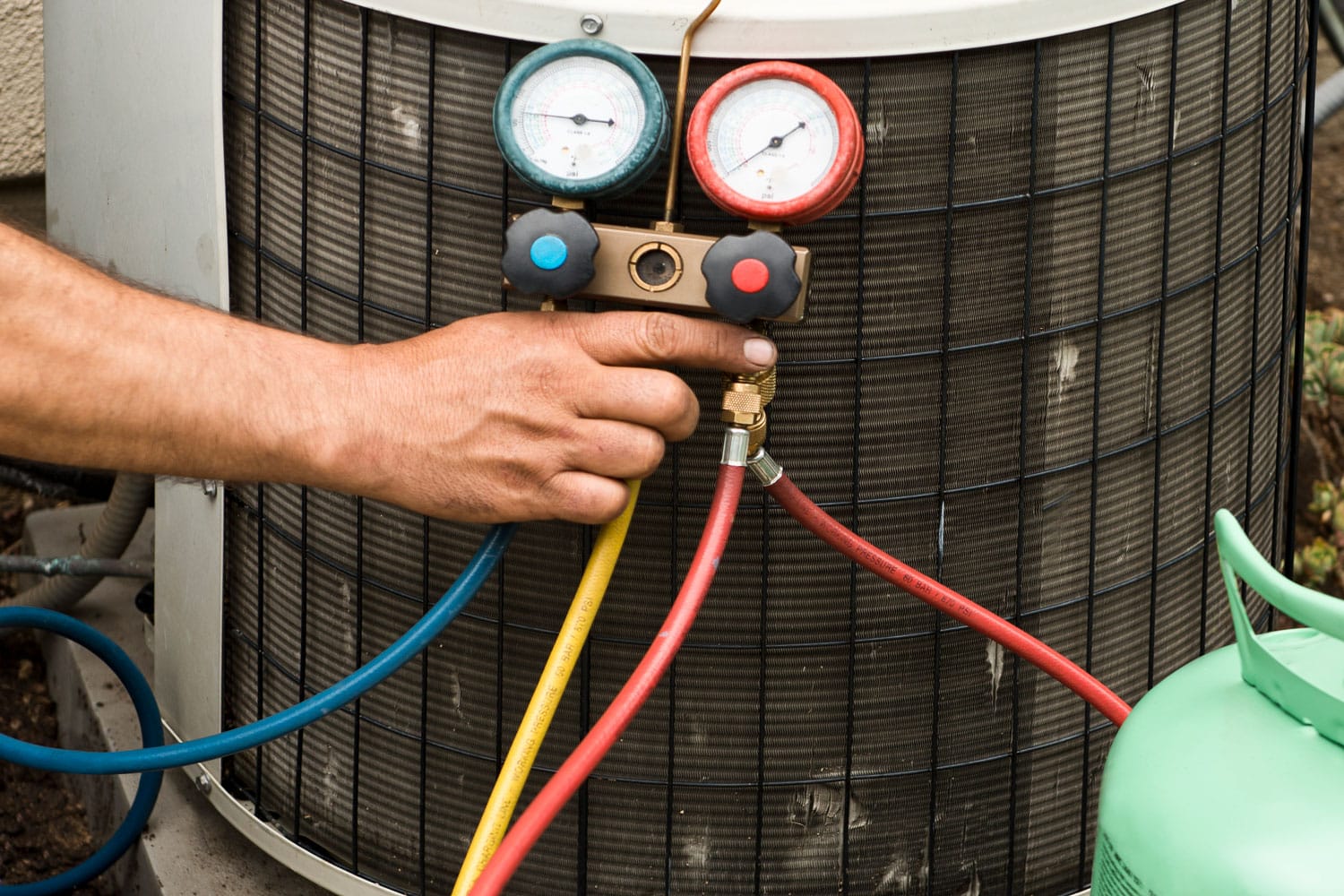It's a lot more convenient to have an air conditioner. It keeps giving you cool and comfortable air. But how does an air conditioner do that? What is a Freon and how much of it does your air conditioner need? Just calm down! We've researched the answers for you.
Usually, air conditioning units need to operate with a Freon of around 60–85 psi for refrigerant R-22 and 105–143 psi for refrigerant R-410a. The range may depend on the preferred refrigerant indicated on your air conditioner.
This time, we'll talk about Freon and how much of it is required for your air conditioner. We'll also discuss other refrigerants and how they contribute to the air conditioning system. You'll learn so much. Just read it all through the end!

How Much Freon In An Air Conditioner?
Freon is a trademark company specializing in refrigerants that we use on our air conditioners. The refrigerant is responsible for supplying chemicals, such as carbon, fluorine, and hydrogen, which are essential for the cooling system.

You need at least 60 psi of Freon for refrigerant R-22. The code R-22 stands for a unique formulation of refrigerant depending on what type of air conditioning unit you'll use.
On the other hand, there is also a refrigerant called R-410a that can activate the cooling system by 105-143 psi. We'll discuss further the differences between these refrigerants.
PSI, or pounds per inch, refers to a unit of air pressure that isolates the chemical components. The air pressure needs to pass through the hose to deliver the refrigerant without losing the volume of its chemical components. In simpler terms, PSI tells the compression level of air pressure.
How Much Refrigerant Do You Need Per Ton of AC Unit?
Tonnage refers to the capacity of an AC unit to cool down an area within an hour. It is measured by a British Thermal Unit (BTU) or defined as the required amount of heat to increase the temperature of a single pound of water by one degree Fahrenheit.
A single ton is equal to 12,000 BTU. It means that you need 0.0016 per square foot, meaning a 1-ton unit covers 600 square feet. Also, it turns out that 20 BTU is equal to one square foot of an area.
So to compute the tonnage of an AC, multiply the ton capacity of an AC by 12,000 BTU divided by 20 to get the square feet area it can cover. See the example below:
How many square feet can a 2-ton AC unit cover?
2 x 12,000 = 24,000 BTU
24,000 ÷ 20 = 1,200 square feet.
Answer: A 2-ton AC unit can cover 1,200 square foot area.
Considering that the general rule is 2-4 pounds of refrigerant for every ton of unit, you need to multiply the range into the tonnage of an AC.
Based on the example above, multiply 2-ton unit to the range of 2-4 pounds. See solution below:
2 x (2 to 4) = 4 to 8 pounds of refrigerant.
So, the final answer would be:
Answer: A 2-ton AC unit can cover 1,200 square feet. Therefore, you need 4-8 pounds of refrigerant to cover 1,200 square feet.
How Does Refrigerant Work?

Refrigerants are used to absorb the room's hot temperature. The air will then flow through the compressor and evaporator until it reaches the condenser, wherein it will then convert the air into a cooler temperature.
As an end result, the fan will spread cool air throughout the room. The cycle of refrigerant continues until the air conditioner demands a refill of refrigerant.
What Are Common Refrigerants?

It's important to distinguish between types of refrigerants for accurate use. We're providing you with the most common refrigerants, namely, R-22 and R-410a. See below the details.
Refrigerant R-22
It's probably the most famous refrigerant. R-22 uses mineral oils that are known to dissolve slower than synthetic oils. It is highly capable of enhancing air conditioning motors.
It also contains HCFC, which is a substance effective for cleaning the air. HCFC stays longer in the air, giving the room a prolonged cool breeze.
Refrigerant R-410a
This is basically an improved version of R-22. It uses a synthetic oil that dissolves easily and prevents overusing air conditioner motors.
Too much content on HCFC is not good for continuous use. Contrary to R-22, R-410a does not harm the air with HCFC. Additionally, studies found that R-22 poses a risk to the atmosphere. Most refrigerant manufacturers stopped producing R-22 due to the harmful emission it can cause to nature, and later switched to making R-410a.
See below an illustration of their differences:
So the next time you look for R-22, they'll probably give you R-410a. However, you should consult an expert before using another refrigerant, as a sudden change of it can cause damage to the air conditioner.
Are Refrigerants Safe?

Most air conditioners are programmed to release a safe amount of refrigerant. You don't have to worry about air safety, as authorities strictly examine both the air conditioning units and refrigerants before making them available for purchase. You just need to find the safety seal from legitimate manufacturers.
In fact, refrigerants are not meant for us to inhale directly. But air conditioners are used in areas where natural airflow is lacking and ventilation is quite hard to achieve. So, refrigerants are made to modify the room temperature and maintain a significant air circulation.
How Long Should You Use an Air Conditioner a Day?

Ideally, the air conditioner should run for 15-20 minutes every 3–4 hours. The cool temperature stays in the air for a few hours.
It's significant to lessen the usage of an air conditioner to stay healthy. If you're worried about using your air conditioner for so long, consider doing these things:
Step Outside
Nothing beats fresh, natural air. You can step outside for at least an hour. This can help you recover from inhaling too much processed air. You can go to open areas with trees.
Open the Windows
Windows are a good exit for polluted air and, at the same time, a useful entrance for better air. You may turn off the air conditioner for a while and let the wind help with proper circulation. You need to let the excessive refrigerant escape through windows.
Switch to Mechanical Fans

It's good not to depend on the air conditioner alone. You could use mechanical fans, for instance, to ventilate the room. You may switch to a ventilator fan every other day. This technique is significant because it lets the air conditioner rest from operating.
See this mechanical fan on Amazon.
When to Refill the Refrigerant?

When the air conditioner stops releasing cooler air, then you need to refill the refrigerant. The condenser motor may overheat if it continues working without enough refrigerant.
The average lifespan of a refrigerant is 10–15 years of use. You can check if the tank will be empty soon and plan your purchase ahead.
How to Refill Refrigerant
Remember that direct contact with refrigerant is quite harmful, both by touching and inhaling it. You should seek help from a technician for its refill. Doing it alone must be done with extreme caution.
Prepare the following things you need to refill the refrigerant:
Gloves and a Mask
Wear a mask and gloves for protection.
Refrigerant
If you're switching to a new refrigerant type, ask a professional first. But most modern air conditioner units use R-410a.
Leak Detector
You need a leak detector because the refrigerant will be useless if you can not detect a leak.
See this refrigerant leak detector on Amazon.
Gauge Set
It's a set of pressure readers to see if the air pressure in refrigerant is normal.
Now, follow these steps:
- Wear a mask and gloves, then turn off the air conditioner.
- Attach the gauge set on the refrigerant based on the color of the hoses. Refer to the product's instructions of use.
- Flip the refrigerator with its canister facing down.
- Twist the canister open, then connect the yellow hose to the gauge quickly.
- Twist open the blue valve.
- Wait until the temperature is displayed on the gauge. Refer to the air conditioner's manual for its recommended temperature range.
- Close the blue valve, and detach the yellow hose. Closecalso the canister.
- Use a leak detector to scan for leaks.
Does Air Conditioner Works Without Refrigerant?

Your air conditioner can run for a short period without a refrigerant, but it will force the motors to shut down. Water will start to leak in the absence of refrigerant. And the worst part is that you can never use your air conditioner again. That's why you cannot force an air conditioner to operate without refrigerant.
Conclusion

You learned so much from this article. We discussed how much Freon your air conditioner requires and how the refrigerant functions.
Provided also are steps to refill the refrigerant and even differentiated its common types. We've mentioned the importance of looking for the safety seal in refrigerants.
Once again, refrigerant is what keeps the air at a cool temperature. But remember that its excessive consumption can cause harm. Just keep it balanced.
Do you want to learn more? You might like these:



